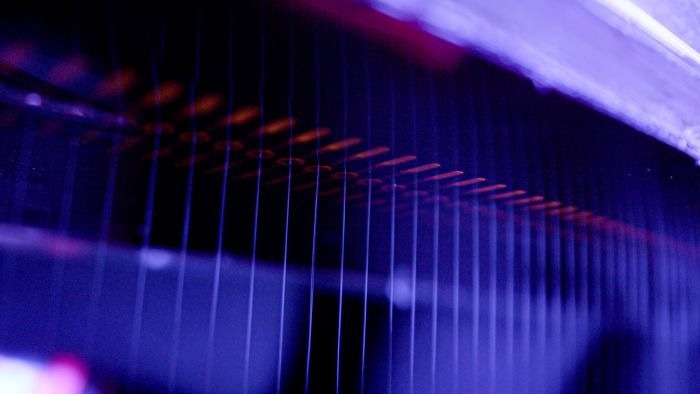Electric motors are central to sustainable mobility and energy efficiency, powering electric vehicles, renewable energy systems, and industrial automation. At their core lies the E-stack—hundreds of laminated steel sheets forming the rotor and stator—engineered to enhance magnetic and electrical performance.
 Quantica NovoJet™ printhead jetting tiny droplets of materials. Image Credit: Quantica GmbH
Quantica NovoJet™ printhead jetting tiny droplets of materials. Image Credit: Quantica GmbH
When it comes to their manufacturing, the bonding of these lamellas are critical, directly affecting the motor’s electrical, thermal, and mechanical properties. High-performance adhesives are the preferred bonding method, offering a stress-free solution which minimizes associated power losses, improves the flatness of the lamella and the noise behavior.
Despite the benefits that adhesives provide, current adhesive application methods like dispensing– depositing large drops across the e-stack sheet and anticipating material spreading when stacking them together– face precision, scalability, and efficiency challenges.
Quantica has developed a fully digital, scalable solution to apply these high-viscosity adhesives, introducing advantages in both e-motor manufacturing processes and performances.
Current Manufacturing Landscape and its Main Limitations
Today, E-stack bonding in rotor and stator manufacturing commonly involves applying the adhesive with analog methods such as dispensing. While adhesives offer clear performance advantages over welding—such as reduced vibration, increased bonding strength, and improved energy efficiency—dispensing processes often struggle with design flexibility, precision, and production throughput.
More specifically, dispensing applies adhesive through a single or limited number of nozzles, resulting in:
- Inconsistent bead sizes and adhesive thickness
- Misalignment due to inaccurate placement at high speeds
- Excess material waste and contamination
- Additional cleaning steps and longer cycle times
These challenges make adhesive dispensing suboptimal for large-scale production and complex rotor-stator geometries, simultaneously affecting e-motor performances. As demand for high-performance e-motors increases, a more scalable, precise, and flexible adhesive application method is required.
The Solution: Quantica’s NovoJet™ Technology
Quantica’s NovoJet™ printhead technology introduces a digital, contact-free alternative to analog adhesive application in e-motor manufacturing. Engineered to handle high-viscosity functional materials—including adhesives up to 250 mPas at jetting temperature—NovoJet™ enables controlled, drop-on-demand deposition with a high degree of accuracy and freedom of design.
The Quantica team successfully jetted a certified industrial adhesive with a viscosity of 85 mPas at 25 °C, curable by heat (90–150 °C) within 60 seconds. As a one-component modified urethane acrylate, its temperature sensitivity prevents pre-heating to lower viscosity, rendering it incompatible with conventional printheads.
By selectively depositing this adhesive onto the lamination sheet, NovoJet™ introduces several advantages for e-motor manufacturers, both in production process efficiency and e-motor performance optimization.
Drop-on-Demand
Drop-on-demand application enables exact placement of each droplet, ensuring uniform adhesive layers and strong, consistent bonding across the entire lamination stack. Compared to dispensing, this level of control enhances motor performance (minimizing eddy currents thermal losses) and offers superior design flexibility that adapts to any lamella shape and pattern.
Material Efficiency
With each droplet individually controlled, the adhesive is applied exclusively where needed. This minimizes material waste, reduces cleanup requirements, and streamlines the production workflow, supporting cost efficiency and environmental sustainability.
Scalability and Integration
NovoJet™ printheads come with 96 nozzles and the possibility for multi-printhead configuration (referred to as print engine). This allows the system to scale with production demand while integrating seamlessly into existing manufacturing lines—without requiring extensive retooling.
Future Outlook and Next Steps in Adhesive Deposition
Looking ahead, Quantica’s digital adhesive deposition technology presents opportunities beyond the rotor-stator interface. The same precision and scalability can be applied to other aspects of electric drive unit manufacturing and other applications like batteries and fuel cell production, including thermal interface materials, electronic components, and motor housing assemblies.As e-mobility evolves and design complexities increase, digital manufacturing solutions like NovoJet™ will be essential in meeting performance standards, reducing production waste, and enabling new levels of functional integration.
At Quantica, we believe digital inkjet printing of functional materials represents a significant shift for the e-motor industry—offering scalable, cost-efficient, and high-performance solutions that align with the future of electric mobility.
If you're interested in exploring digital adhesive deposition for your e-motor production lines, or for similar manufacturing processes, we invite you to connect with us and learn how Quantica can support your production.
How Advanced Inkjet can Improve E-Motor Manufacturing and Performance
Video Credit: Quantica GmbH